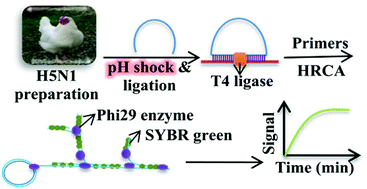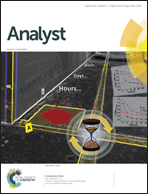Real-time detection of H5N1 influenza virus through hyperbranched rolling circle amplification
Abstract
An isothermal amplification method was developed for the sensitive detection of the H5N1 influenza virus. The padlock probe specifically bound to the H5N1 target and circularized with T4 DNA ligase enzyme. Then this circular probe was amplified by hyperbranched rolling circle amplification (HRCA) using Phi29 DNA polymerase. The fluorescence intensity was recorded at different intervals by intercalation of SYBR green molecules into the double-stranded product of the HRCA reaction. At an optimum time of 88 min, a calibration plot with fine linearity was obtained. Using HRCA based on a padlock probe and Phi29 DNA polymerase, high selectivity and sensitivity were achieved. The biosensor response was linear toward H5N1 in the concentration range from 10 fM to 0.25 pM, with a detection limit of 9 fM at a signal/noise ratio of 3. By replacing the heat shock with pH shock, not only was the procedure for detection of H5N1 influenza simplified, but also the DNA molecules were protected from possible breaking at high temperature.


 Please wait while we load your content...
Please wait while we load your content...